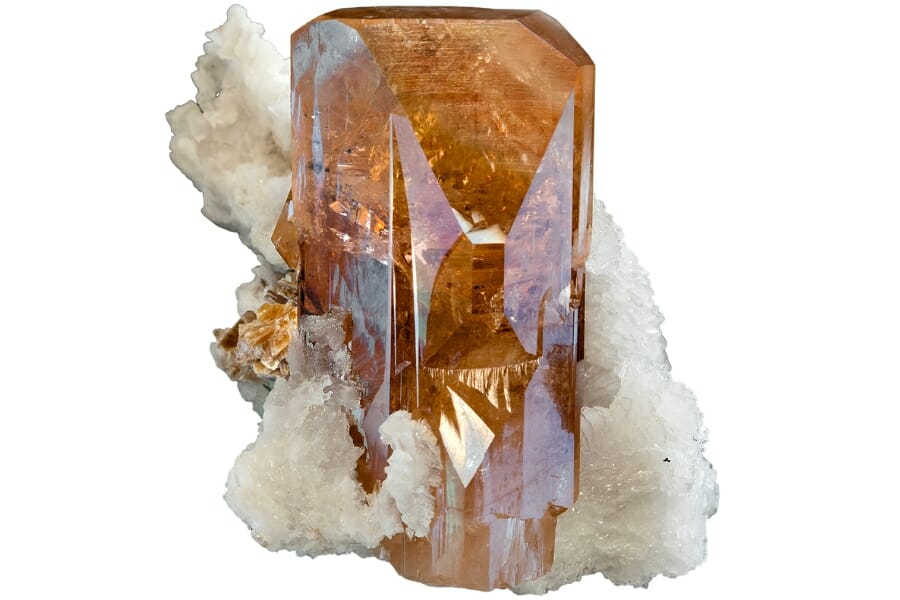The name topaz might be familiar, but would you recognize a real topaz if you saw one? Many people don’t realize that there are countless other crystals and gemstones that can be easily mistaken for it.
But don’t worry, because we’re here to give you handy tools on how to identify topaz and how to tell if topaz is real. We’ll dive deep into the world of this gemstone— its unique properties, where it comes from, and why it’s so valued. But most importantly, we’ll share with you practical tips to identify a genuine topaz.
By the time you finish reading, you’ll have a clearer understanding of this gemstone and will be able to confidently differentiate between a real and a fake topaz. Ready to become a topaz pro? Let’s dive in!
Overview Of Natural Topaz And Why Fakes Are Common
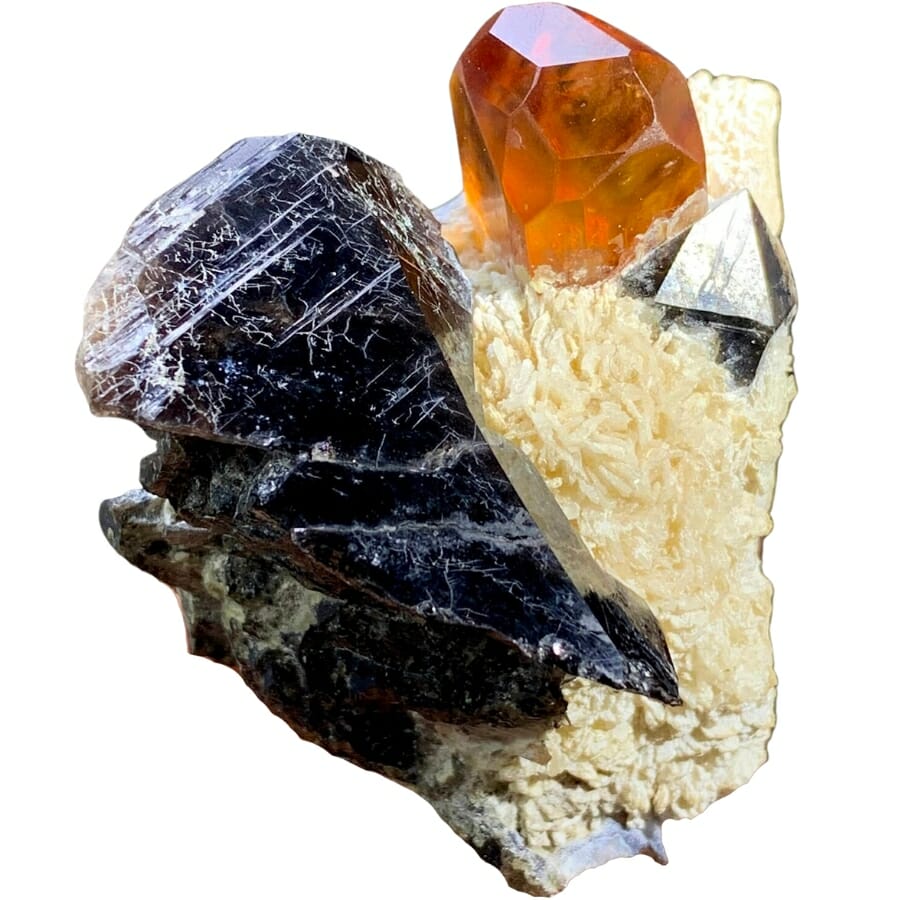
Topaz forms in areas where hot molten rock or magma cools down and hardens over thousands to millions of years. During this cooling process, certain elements and minerals come together in just the right way to form crystals.
One of these crystals is topaz. Often, it can be found in cracks and cavities of rocks, especially in places where the rock has been changed by heat and pressure.
Interestingly, topaz has a wide range of colors. While many think of it as being blue, it can also be clear, yellow, orange, red, green, and even pink. Sometimes, its color can change because of treatment or exposure to heat.
The value of topaz is high for a number of reasons. First, its range of stunning colors and crystal clarity make it a favorite for many people. Also, its hardness means it can last a long time and not get damaged easily.
But like all gems, the most valuable topaz stones are those that are rare. For example, natural pink or red ones are much rarer than blue or clear pieces. Whether you’re wearing it, collecting it, or just admiring it, topaz is sure to impress.
Why you’re seeing more fake topaz these days
Recently, there have been more fake topaz stones showing up on the market. Why is this happening?
First, genuine topaz can be expensive, especially the rare colors like pink or red. So, some people try to make more money by selling fake topaz at the price of real ones.
Second, technology has improved a lot. This means it’s easier now to make fake gems that look a lot like the real thing. Some of these fake stones are made from materials like glass or cheaper crystals and then treated to look like topaz.
Also, there’s a big demand for topaz jewelry. Since more people want to buy it, some sellers might try to trick them with fakes, especially if the buyer doesn’t know how to tell the difference.
Finally, online shopping has become more common. While it’s convenient, it’s also harder to check a gem’s quality or authenticity through pictures alone. This can make it easier for sellers to pass off fake topaz as real ones.
How To Identify Real Topaz
It’s a challenging but rewarding experience to learn how to identify your rocks, especially since many of these wonders, both natural and man-made, share the same qualities.
To help you tell for sure that what you’re in possession of is a topaz, below are helpful tips you can follow:
Look for uniform coloration throughout
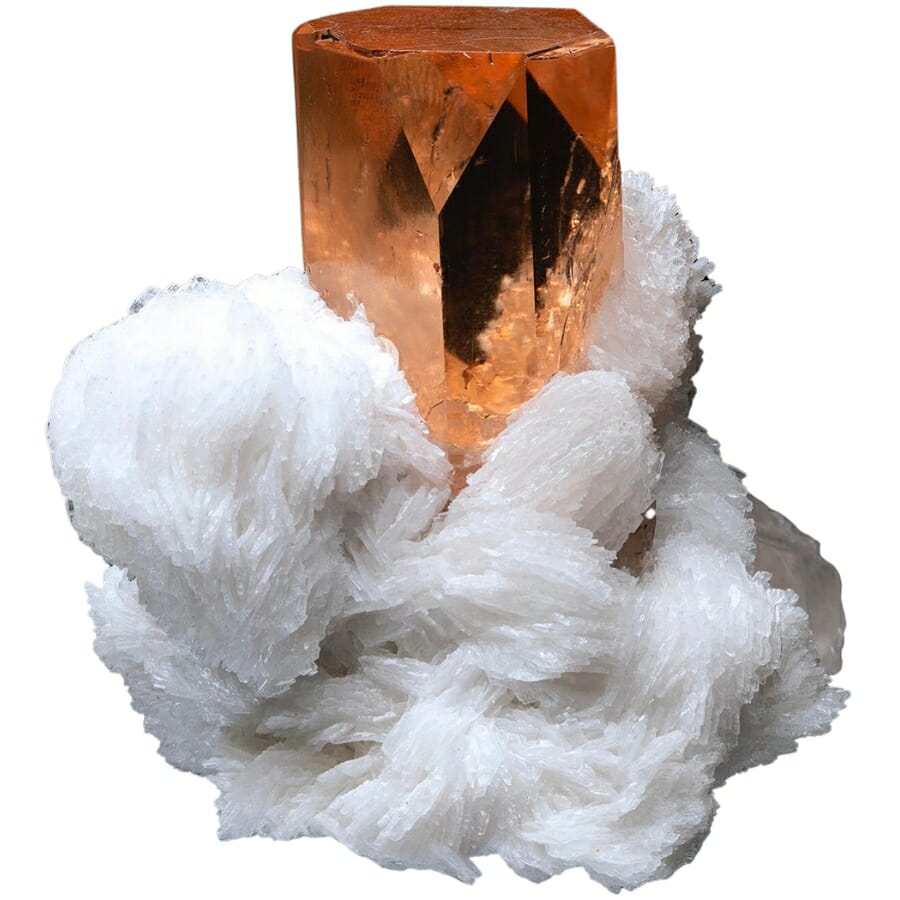
Topaz with cleavelandite photo provided by Mineral Masterpiece
When you’re checking if a topaz is real, looking at its color can give you some clues.
Genuine topaz often has a color that’s consistent or the same all through the stone. This means if you look at the gem from different angles, the color should mostly stay the same.
Why does this matter? Well, fake topaz or other imitations, like colored glass, might not be made as carefully. These might have blotchy spots or areas where the color looks different. Think of it like painting a wall; sometimes you might miss a spot or put too much paint in one place. The same can happen when making fake gems.
So, by making sure the color of a topaz looks even and steady, you have a better chance of knowing it’s the real thing!
Check for imperfections
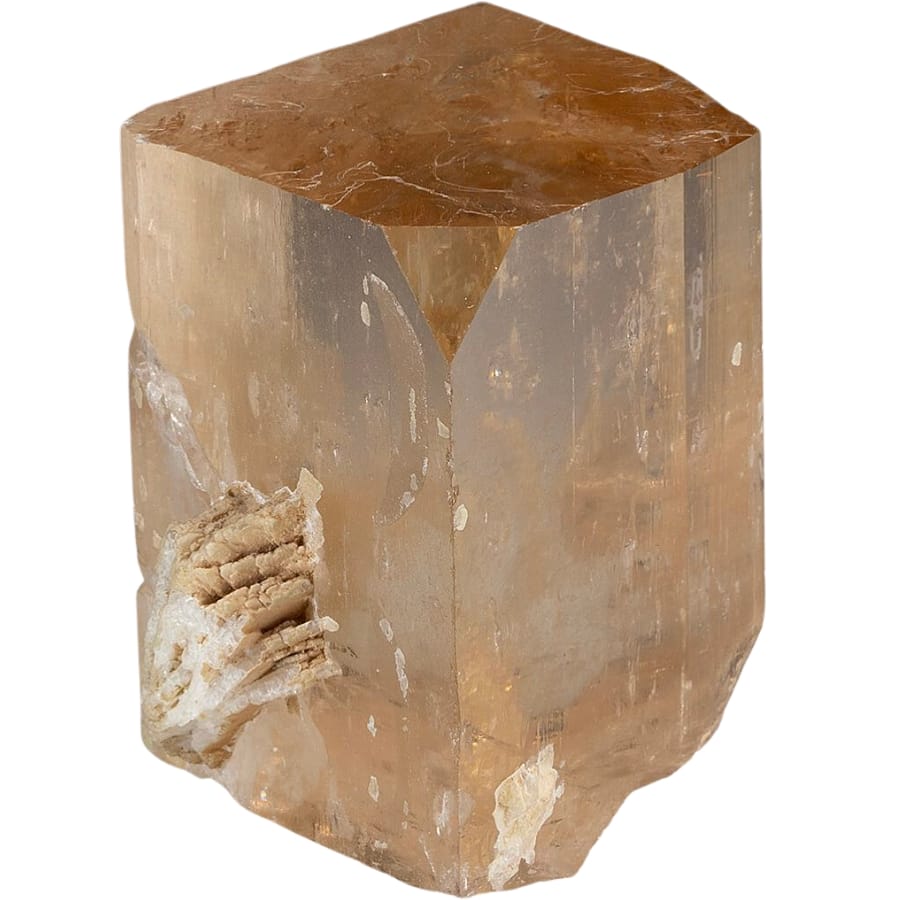
When you’re looking at topaz, seeing small imperfections, or what experts call inclusions can be a good sign. These inclusions are natural and can look like tiny lines, dots, or clouds inside the stone.
Nature isn’t always perfect, and when topaz forms deep in the Earth, it often captures tiny bits of other minerals or has slight irregularities.
On the other hand, fake topaz, like ones made of glass or plastic, will often look too perfect because they’re man-made in factories.
If your topaz has tiny imperfections, it’s more likely to be genuine. But remember, this is just one clue. It’s always a good idea to check a few things before deciding if a gem is real.
See if it has a weak glow under UV light
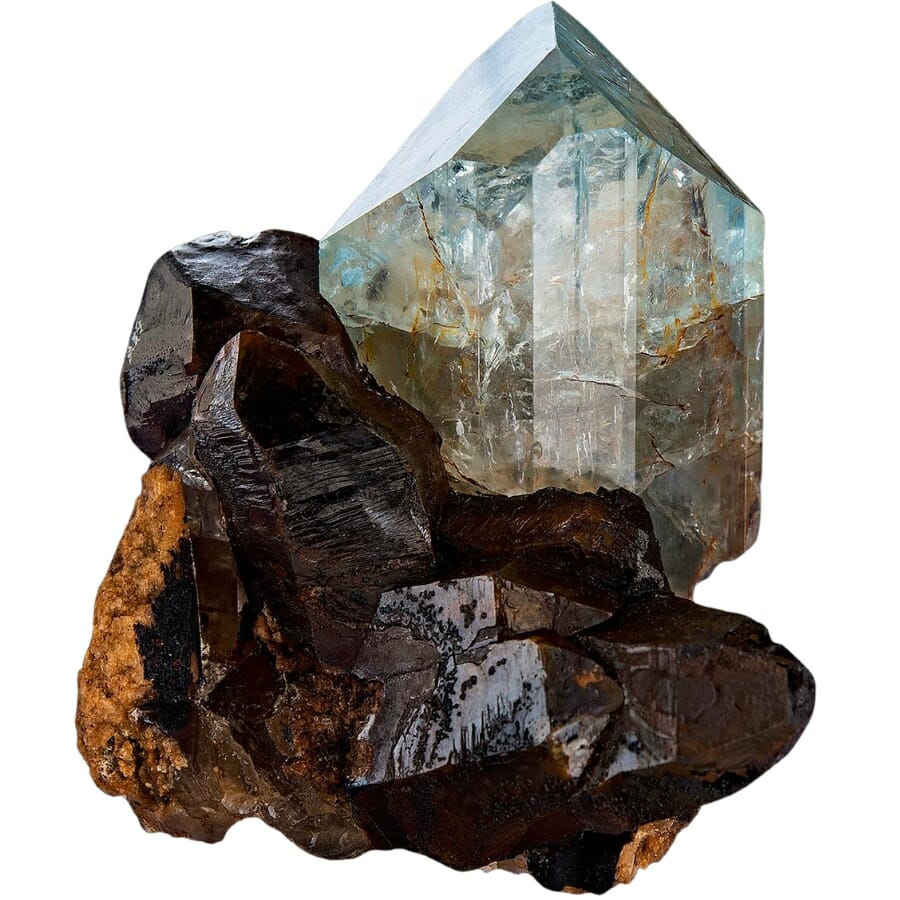
Checking how a gem reacts to UV light is like a cool detective trick! Some things glow or fluoresce when they’re under ultraviolet light, kind of like how certain clothes or posters glow in the dark.
Here’s the thing about topaz: some real topaz can show a weak glow when you shine UV light on it. Fake topaz, especially if it’s made from certain types of glass or other materials, usually doesn’t have this glow.
However, not all real topaz will show a weak glow under UV light, so if it doesn’t glow, it doesn’t mean it’s fake. But this is one good test that you can do, along with others, that’ll help you know if you’re holding a real piece of topaz in your hand.
Test its hardness
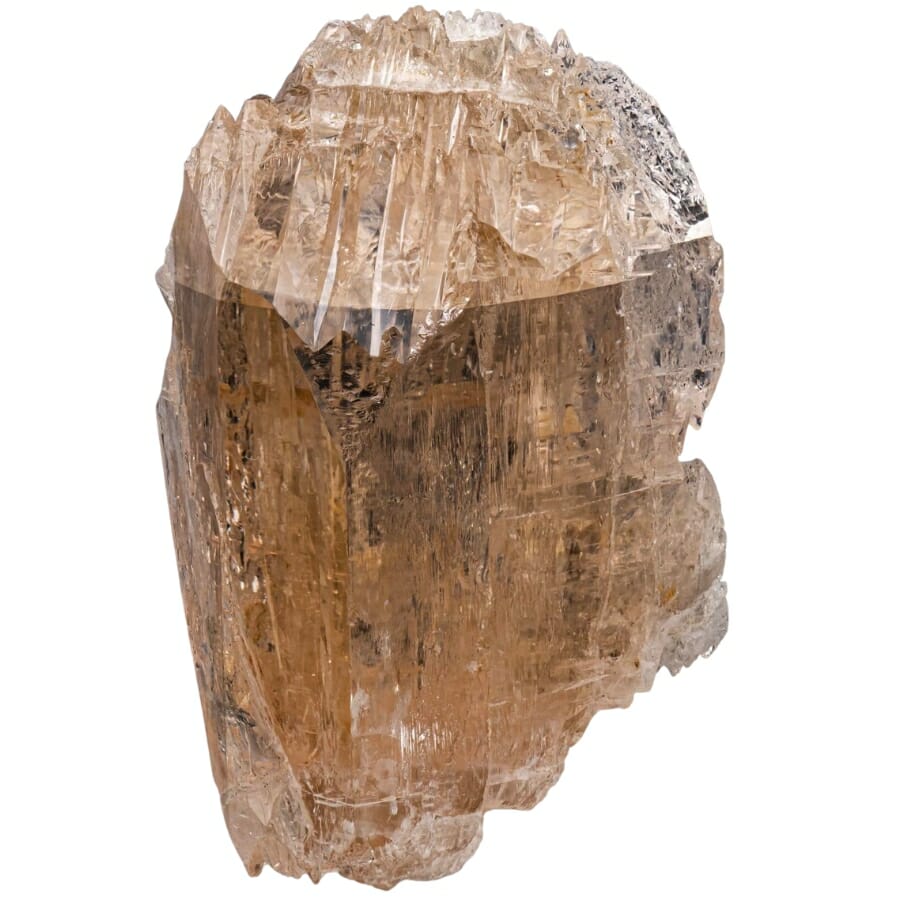
On Moh’s scale of hardness from 1 to 10, topaz scores a strong 8, which means it’s quite hard and not easy to scratch. Just to give you an idea, the only natural gem harder than topaz is a diamond, which scores a perfect 10!
If you have a piece of topaz, testing its hardness can be a helpful way to see if it’s real. You can try to scratch it with something softer, like a penny, and the topaz should remain unscratched.
But be careful, if you use something harder, you could damage the gem, even if it’s real.
Fake topaz, made from glass or plastic, is usually much softer. So, if you can easily scratch your gem, there’s a good chance it’s not real topaz.
The Different Types Of Fake Topaz And What They Look Like
In this section, we’ll go through the most popular and widespread rocks, both natural and man-made, that are sold as fake topaz. It pays to know how similar they are to real topaz and what differences you can observe for yourself to set them apart.
Glass Imitations
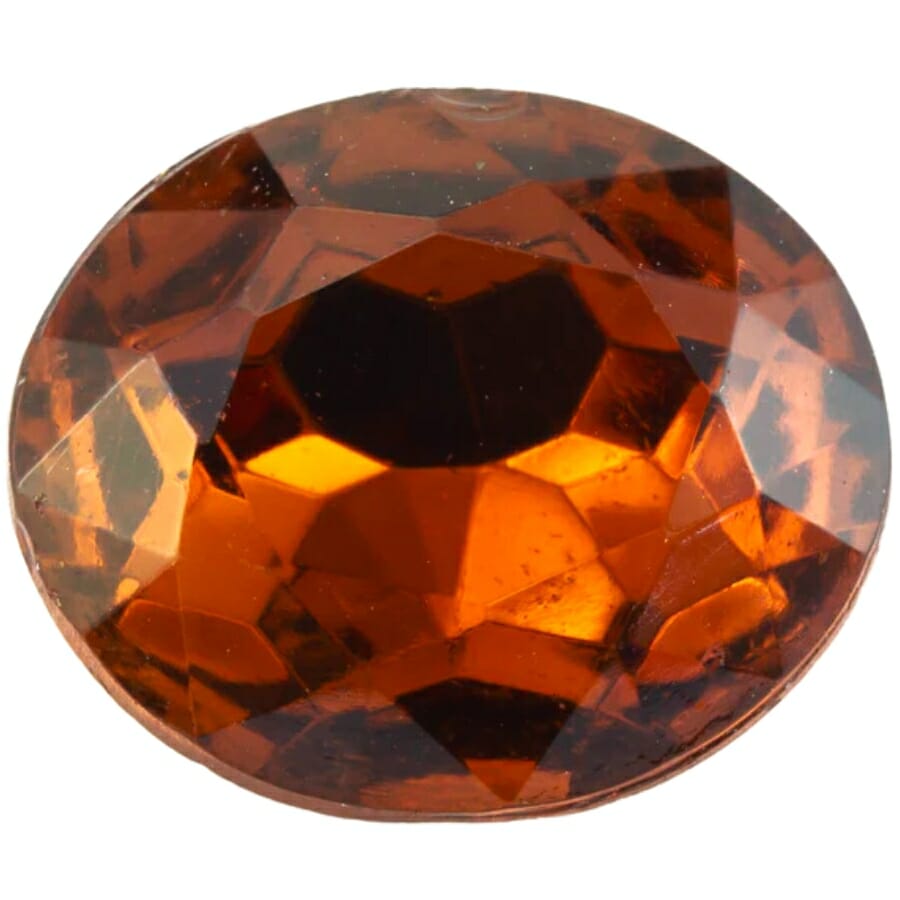
To make a topaz glass imitation, manufacturers add different chemicals and metal oxides with basic glass materials, like silica sand, to create a color that looks like real topaz. For example, adding cobalt gives the glass a blue tint similar to blue topaz.
Once the colored glass mixture is created, they melt it at high temperatures until it becomes liquid. Then, they pour or press this melted glass into molds shaped like gemstones. After it cools down and hardens, they get a rough shape of the gem.
Next comes the cutting and polishing. This is the part that makes the glass shine and sparkle. Craftsmen use special machines to cut the rough glass into beautiful shapes, just like how real topaz would be cut. They polish it until it’s super shiny.
Some sellers, hoping to make more money, will sell these glass imitations as if they were real topaz. Since they look a lot like the real thing, especially to someone who isn’t an expert, people can get fooled.
How you can identify glass imitations being sold as real topaz
Check its weight and feel on your hands
Glass is generally lighter than real topaz. If you pick up a piece of jewelry and it feels lighter than you’d expect, it could be a glass imitation. Plus, genuine topaz usually feels colder to the touch compared to glass.
Do a scratch test
Topaz is harder than glass. If you can easily scratch the stone with a knife or a steel pin, it’s likely glass. But be careful, you don’t want to damage a real gem by mistake!
Look closely if there are bubbles inside
If you closely look at the stone, especially under a magnifying glass, and you spot tiny bubbles inside, that’s a telltale sign of glass. Real topaz won’t have these bubbles.
Quartz
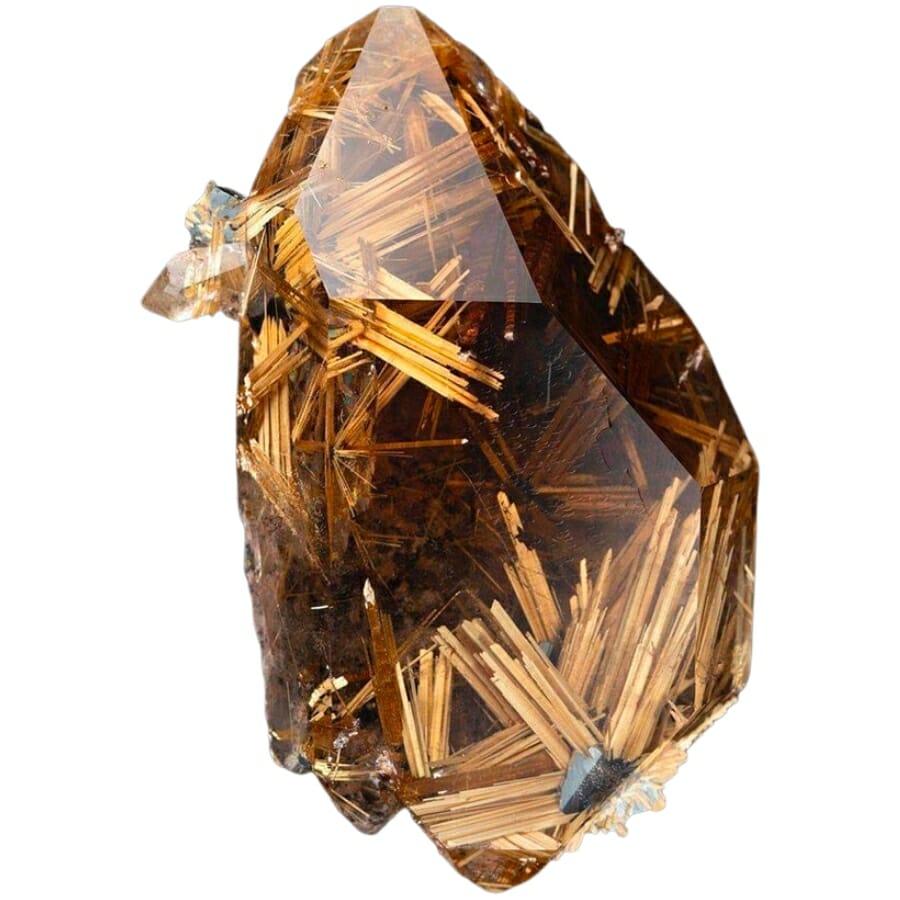
Quartz is one of the most common minerals on Earth, and it can be found in various colors like clear, pink, purple, or even yellow.
This gem forms when certain minerals, like silicon and oxygen, come together in the right conditions. Over time, these crystals grow larger as more and more material gets added.
Some quartz, especially the clear or yellowish kind, can look a lot like topaz. Some sneaky sellers take advantage of this similarity to fool people. They heat or treat the quartz to make its color look more like topaz. After this, they cut and polish the quartz so it shines brilliantly, making it even harder to tell apart from real topaz.
But wait, there’s more! Sometimes, sellers will even label quartz as “topaz quartz” to make it sound more valuable. But don’t be fooled! While both are beautiful gemstones, topaz and quartz are two different minerals.
How you can identify quartz being sold as real topaz
Test its hardness
One big difference between topaz and quartz is their hardness. Topaz is harder than quartz. If you gently try to scratch the surface with a steel file or pin, and it scratches easily, it might be quartz.
Examine if it has double refraction
When you look closely at quartz, especially through the side, you might see a neat effect: images or lines behind the stone seem to double. This “double vision” is called double refraction. Topaz doesn’t show this effect, so if you see it, you’re probably looking at quartz.
Check the price
If the deal seems too good to be true, it might be! Genuine topaz usually costs more than quartz. If someone’s selling a “topaz” for a really low price, be suspicious. It might be quartz in disguise.
Cubic Zirconia
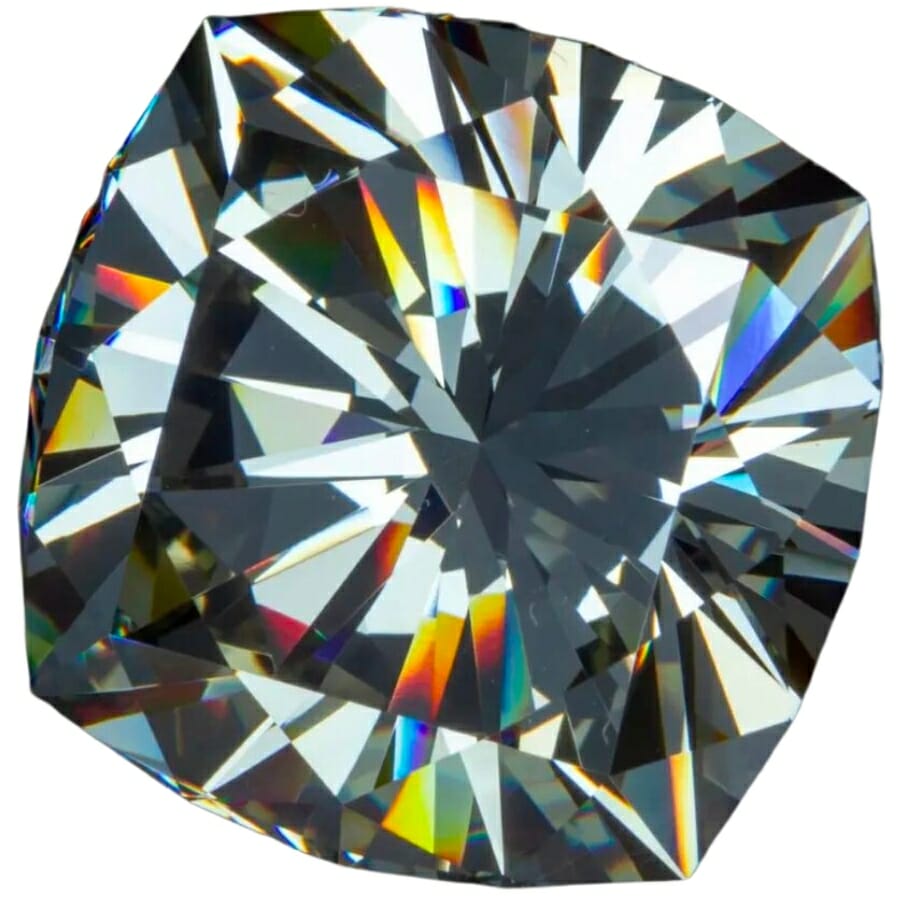
Cubic zirconia, often called CZ for short, is a man-made crystal. It’s not something you’d find in nature like diamonds or topaz. Instead, it’s made in labs using zirconium dioxide.
Scientists heat this material up to high temperatures, around 5,000 degrees Fahrenheit! When it melts, they can shape and cool it to form clear, sparkling crystals that look a lot like diamonds.
While many people know CZ as a diamond substitute, it can also be made to look like topaz. By adding different elements or using special treatments, scientists can change the color of CZ to mimic the various shades of topaz.
After getting the right color, the CZ is then cut into gemstone shapes and polished until it shines brightly. To the untrained eye, these CZ stones can look a lot like real topaz, especially when set in jewelry.
How you can identify cubic zirconia being sold as real topaz
Observe its brilliance
Cubic zirconia is known for its intense sparkle. It reflects light in a colorful, rainbow-like way, often more than real topaz. So, if the stone seems to shine with all the colors of the rainbow very vividly, it might be CZ.
Check its weight
Cubic zirconia is a bit heavier than topaz. If you’ve handled gemstones before and the one you’re examining feels heavier than you’d expect for its size, it could be cubic zirconia.
Looks for flaws and imperfections
Nature isn’t perfect, so real topaz might have tiny imperfections inside. Cubic zirconia, being made in a lab, often comes out looking perfect with no flaws. If your stone looks super clear with no to little marks or imperfections, be cautious—it might be CZ.
Fluorite
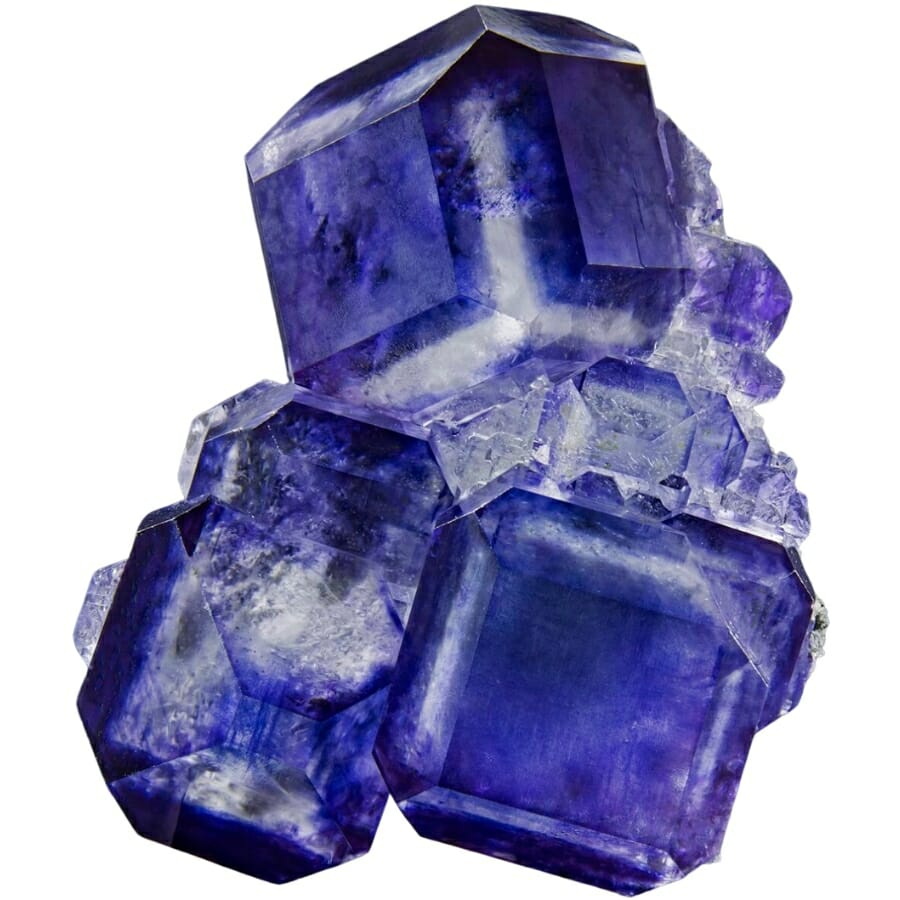
Fluorite is a naturally occurring mineral that’s formed when hot water packed with minerals flows through rocks. Over time, these minerals build up and crystallize into fluorite. One cool thing about this gem is that it can be found in a rainbow of colors!
Because fluorite can be clear or colored in ways similar to topaz, some sneaky sellers try to pass it off as the more expensive topaz. Plus, fluorite has a glassy shine which can make it look very gem-like, adding to the confusion.
Sometimes, fluorite is treated or heated to enhance its color or clarity, making it look even more like real topaz. When set in jewelry or polished up, it can be pretty convincing.
But while fluorite is beautiful in its own right, it’s not as valuable or durable as topaz.
How you can identify fluorite being sold as real topaz
Try a hardness test
Fluorite is softer than topaz. If you can scratch the stone with something like a steel nail or knife without much effort, it might be fluorite. Real topaz would resist those scratches much better.
Examine its color
While both fluorite and topaz come in various colors, fluorite often shows up in bright purples, blues, and greens. If the gem has a very vibrant color, especially a deep purple, be suspicious— it might be fluorite.
Check for fluorescence
Here’s a fun fact: the word “fluorite” comes from the Latin word for “flow,” because many fluorite minerals glow under ultraviolet (UV) light! So, if you shine a UV light on the stone and it glows or exhibits fluorescence, it’s probably fluorite.
Scapolite
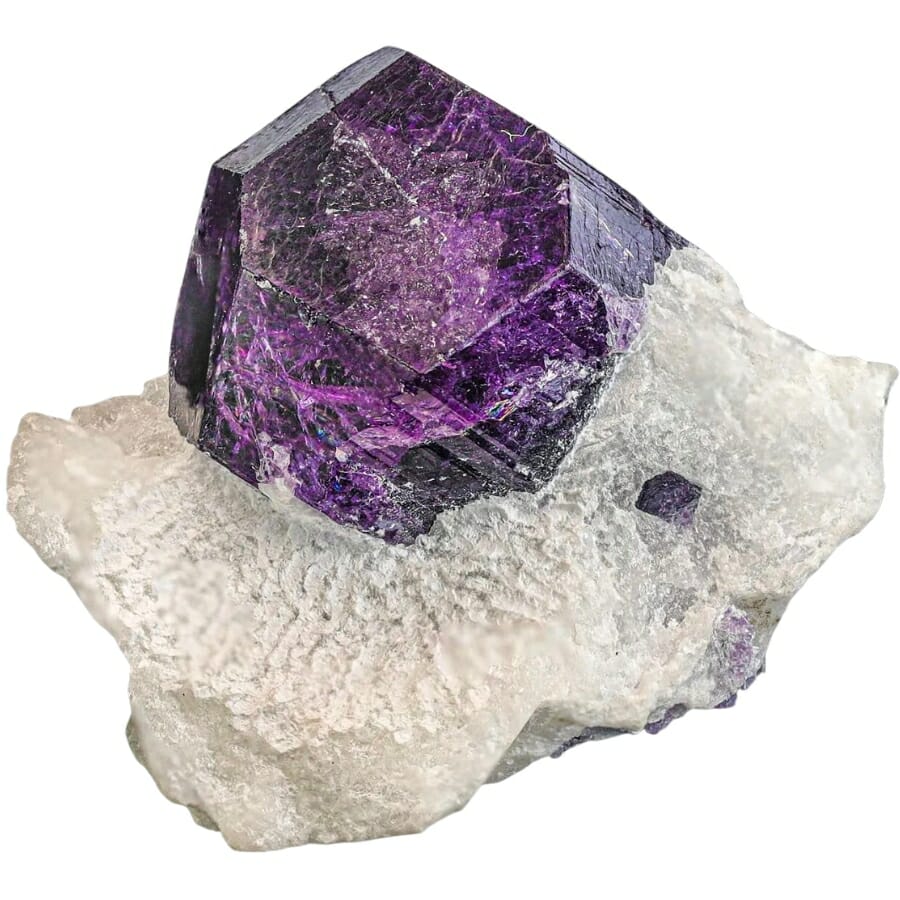
Scapolite is formed when rocks, under a lot of heat and pressure, react with watery fluids. Over time, these reactions cause certain minerals to form, including scapolite. This mineral can be found in places where rocks have been changed by heat or where they’ve been squished by the movement of the Earth’s plates.
One of the reasons why scapolite might be mistaken for topaz is because of its look. It can be clear, yellow, pink, or even violet. Plus, its shine can make it look quite pretty, similar to the allure of a real topaz.
Since topaz usually costs more money, sometimes sellers make scapolite look like it and then sell it without disclosing that it’s fake topaz. Sometimes, they treat or modify the scapolite to make it look even more like the real thing.
How you can identify scapolite being sold as real topaz
Examine for inclusions
Scapolite often has thin, needle-like inclusions or tiny bits or imperfections inside it. If you see these using a magnifying glass or jeweler’s loupe, it might hint towards the stone being scapolite.
Check the price
As with many gem imitations, the price can give you a clue. If a “topaz” stone is selling at a much lower price than others you’ve seen, it might be a different mineral, like scapolite, posing as topaz.
Inspect the luster
While both stones can be shiny, scapolite usually has a glass-like sheen, which is different from the brilliant luster of topaz. If the stone’s shine reminds you more of glass than a dazzling gem, be cautious.
How To Tell If Topaz Is Real Vs Fake
The fake topaz that we’ve shared above are only some of the many counterfeits and topaz-wannabes that you might encounter when trying to purchase this gem.
So to help you learn how to tell if topaz is real, below are some signs that it’s fake, whether you have a cut, polished, or raw crystal in your hands.
How to identify fake topaz when it’s cut or polished
Distinguishing genuine topaz from its cut or polished look-alikes is a challenge on its own. But don’t fret! We’ll arm you with the knowledge to confidently differentiate real topaz from its many pretenders.
Keep an eye out for the following characteristics of a fake topaz:
Uniform coloration throughout
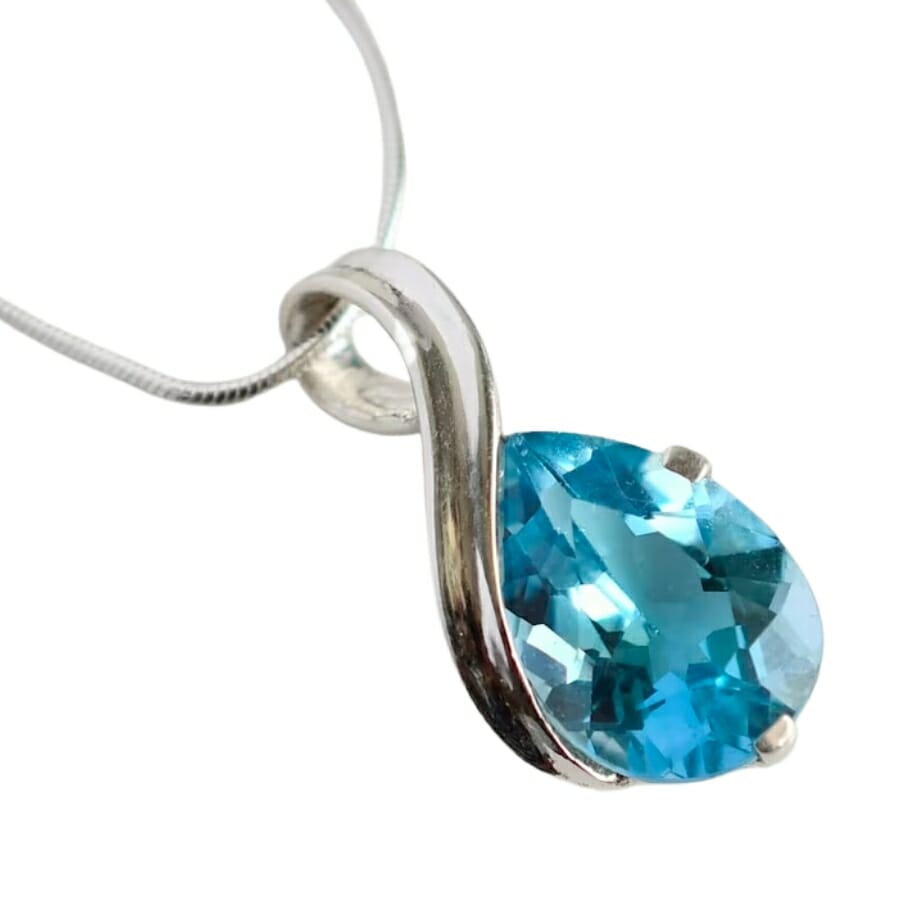
Topaz comes in a range of colors— from clear to blue, yellow, or even pink— and its hues are part of its charm. But when you’re looking to buy a genuine topaz, there’s a color-related tip that can help you spot a fake: check how even and uniform the color is throughout the stone.
Real topaz often has slight variations in its color. Mother Nature rarely makes gemstones with perfectly consistent color. When you look closely at a genuine topaz, you might see some areas that are a bit lighter or darker than others.
This is natural and is a result of how the stone was formed over millions of years. These tiny color differences can be like a fingerprint, unique to each gemstone.
On the other hand, many fake topaz stones, especially those made of glass or other man-made materials, will have a very even color throughout.
This is because, during manufacturing, the coloring agents are mixed evenly, resulting in a stone that has a perfectly consistent shade. While this might sound good, it’s actually a big clue that the stone isn’t real topaz.
Double refraction
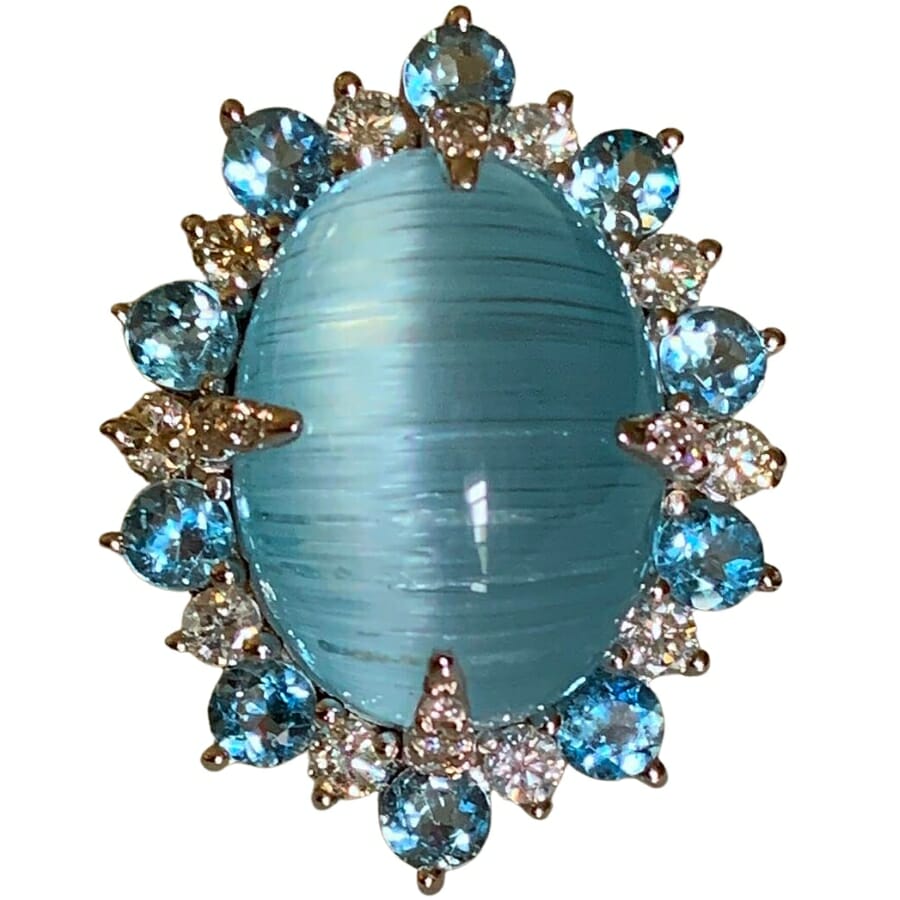
As we’ve described in passing earlier, when light passes through some gemstones, it splits into two rays. This means when you look through them, you might see two images of something instead of just one. This effect is called double refraction.
Topaz doesn’t show double refraction. So, if you’re looking through a gem and you see double images, that’s a clue that the stone might not be a real topaz.
There are tools, like a gemological microscope, that can help you see this effect clearly. But if you don’t have one, don’t worry! You can sometimes spot this with your naked eye or a simple magnifying glass.
Hold the gem up and look through it at a straight line or a dot. If the line or dot appears doubled, that’s the double refraction in action.
Very low price
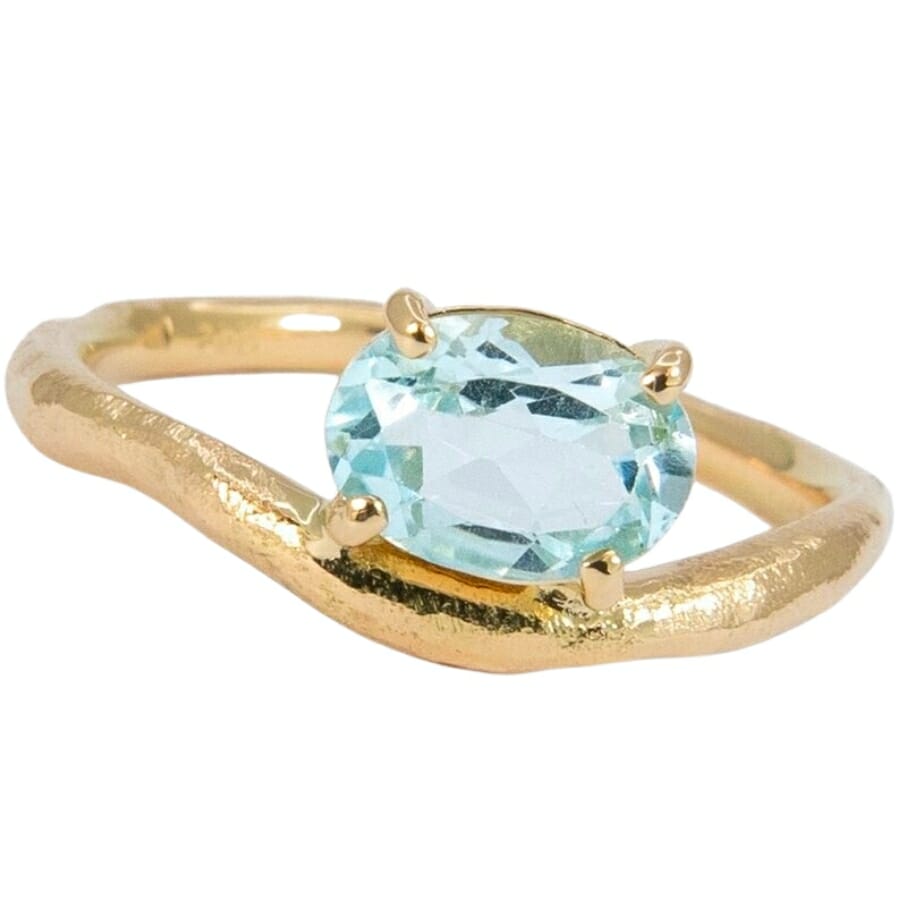
Imagine walking into a store and seeing a pair of sneakers that normally cost $100 being sold for just $10. It might make you wonder if those sneakers are genuine or if there’s something off about them. The same idea applies to gems, including topaz.
Topaz, especially the high-quality kind with beautiful colors, can be pretty pricey. If you come across a stone that’s being sold as topaz but has a super low price, it’s a big red flag.
Sellers might drop the price really low on fake topaz because, well, it didn’t cost them much to get it in the first place.
However, it’s essential to remember that not all affordable topaz is fake. Sometimes, sellers offer genuine topaz at lower prices because of a sale or if the stone has some imperfections. But, if the deal seems too good to be true and other signs make you suspicious, it’s always smart to be cautious and ask questions.
How to identify fake topaz when it’s raw
Before it’s cut and polished, determining the authenticity of topaz can be quite challenging due to its similarity to other minerals. Below are some of the most helpful things you can do to distinguish genuine raw topaz from its deceptive lookalikes.
Easily scratched
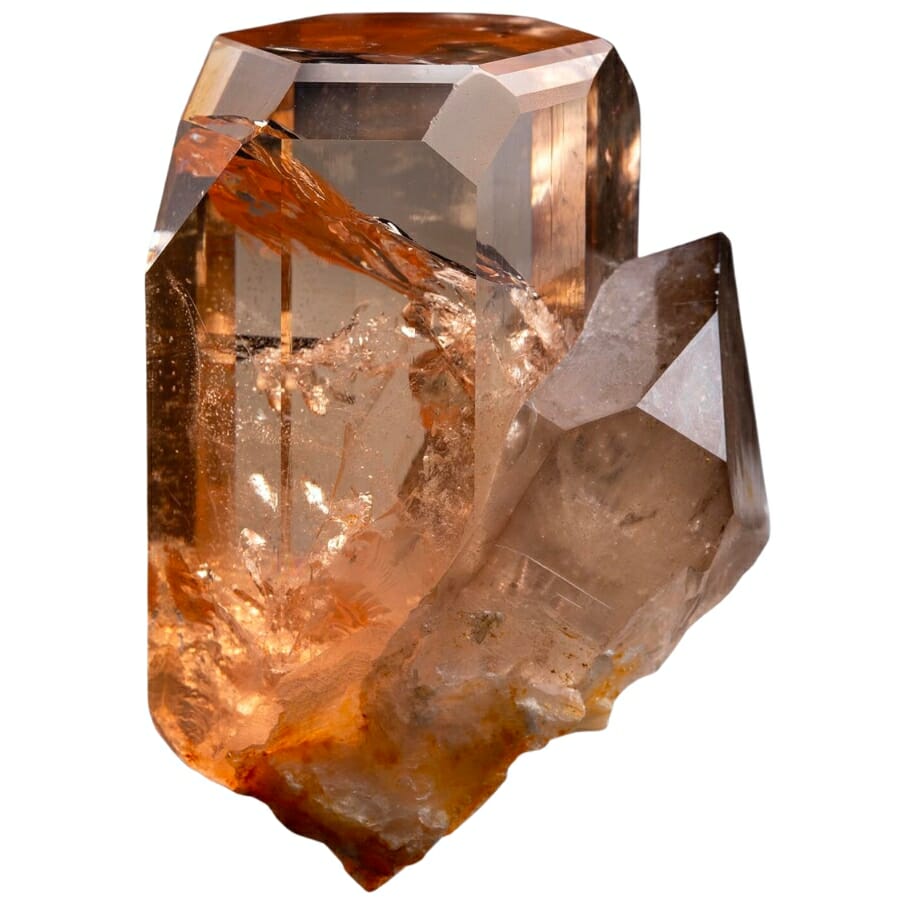
One key way to figure out if a raw and uncut stone is real topaz or not is by looking at how easily it gets scratched.
Topaz is a pretty hard mineral, scoring an 8 out of 10 in the Mohs scale. That means it’s harder than a lot of other minerals and gemstones.
If you have a raw stone and you think it’s topaz, try scratching it with something softer, like a fingernail or a copper penny. If it gets scratched, it’s probably not real topaz.
But, remember to be careful when doing this test because you don’t want to damage a potentially valuable stone.
Multiple bright colors within
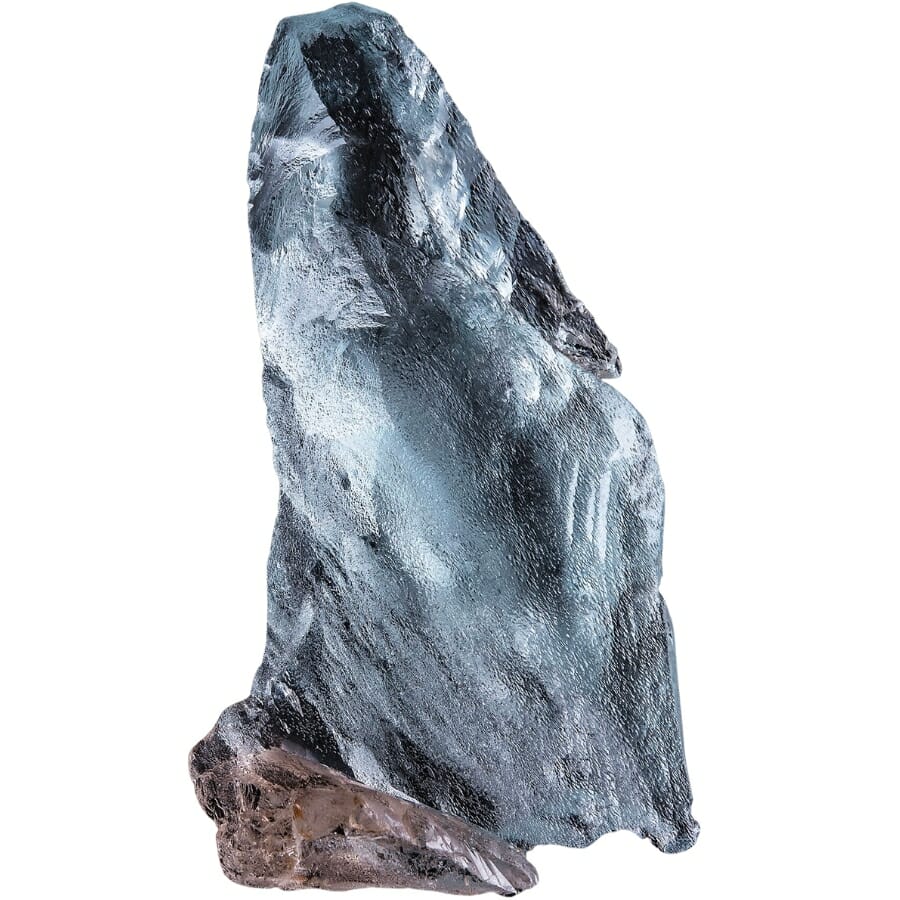
When you’re looking at raw and uncut stones, spotting bright, multiple colors can be a clue that a topaz might be fake. Real topaz usually has one color in varying intensities throughout the stone.
While it can come in various colors like blue, yellow, pink, and brown, it’s not common for a single piece of topaz to have many bright and distinct colors mixed together.
Some minerals or synthetic stones might have swirls of different colors or bright spots inside them. These colorful inclusions or patterns can sometimes be mistaken for topaz, especially if you’re not sure what to look for.
But if you see a raw stone with too many colors or unusually bright patches of color, be cautious. It’s also good to remember that topaz is often treated to enhance its color. In its natural, raw form, though, it should not have wild, rainbow-like colors.
Too perfect
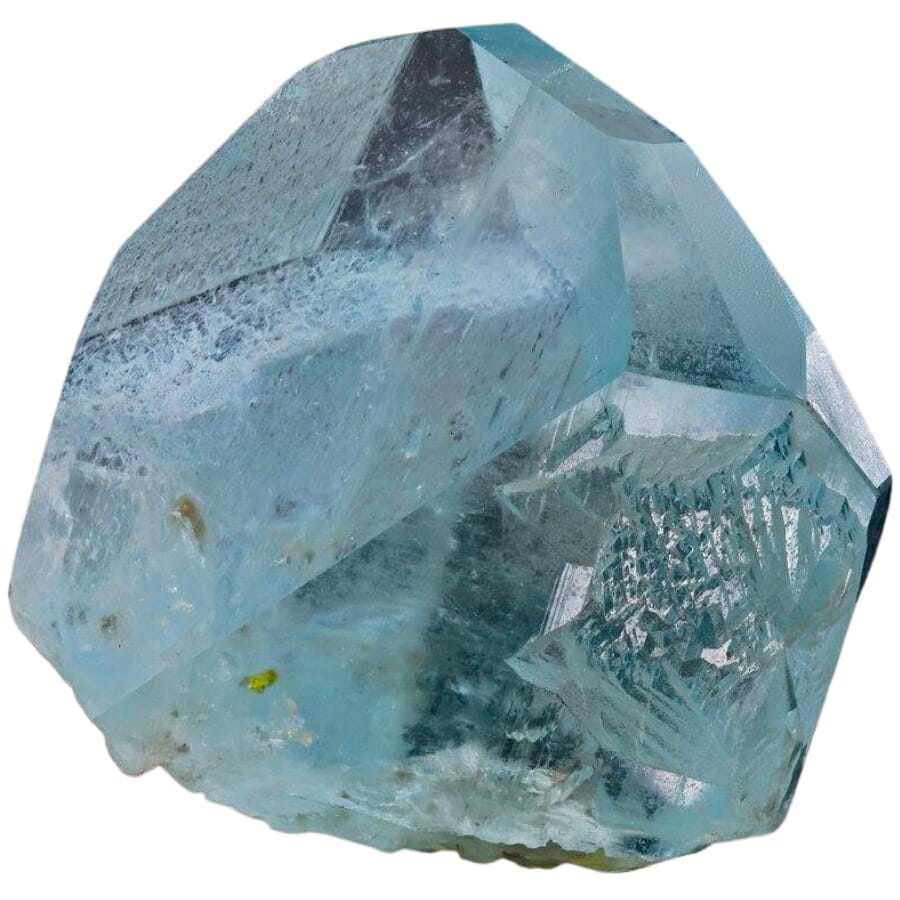
Nature, in all its beauty, rarely creates things that are completely flawless. This is true for gems as well.
Real topaz, when raw and uncut, will usually have some imperfections. These could be tiny cracks, inclusions, or even some uneven coloration. If you come across a piece of raw topaz that looks too perfect, you might want to think twice.
Fake topaz, especially the ones made in labs, can look super clear and almost too perfect. That’s because they’re made in controlled environments where it’s easier to prevent flaws from forming.
While they can look beautiful, they lack the natural and unique characteristics that real topaz has. So, when shopping for raw topaz, don’t just go for the shiniest and most flawless piece. Instead, look for those tiny imperfections.

